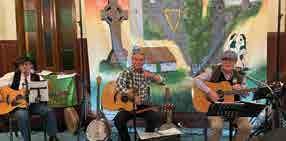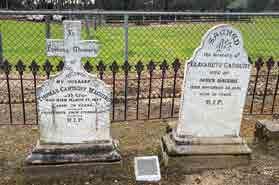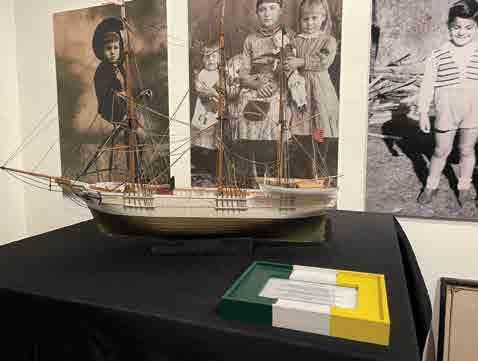
5 minute read
One Irishman, Two Great Escapes and a Bit of Craic
BY SHARON BARBA
WESTERN AUSTRALIA’S CONNECTION TO THE IRISH FENIAN STORY WAS THE FOCUS OF THE JOHN BOYLE O’REILLY WEEKEND COORDINATED BY THE FENIANS, FREMANTLE AND FREEDOM! (FFF) GROUP.
Advertisement
Sixty-two Fenians were transported to Western Australian on board the Hougoumont in 1867, including John Boyle O’Reilly. O’Reilly was a talented poet, journalist, and editor and a widely respected advocate for many humanitarian causes. The weekend tour traced John Boyle O’Reilly’s involvement in two dramatic escapes: his own bid for freedom in March 1869, and the rescue of six Fenians in 1876 on board the Catalpa, which O’Reilly was instrumental in facilitating. Margo O’Byrne, FFF Chairperson, was our expert guide throughout this fascinating journey through time and space. We were especially privileged to enjoy the company of two people with a direct connection to those heady days: Nicole Anderton, a descendant of William Anderton, a convict who arrived on the Hougoumont, and Anne Golden, who spoke to us about her ancestor, John Golden, a hero of the Kerry uprising. The tour kicked off from the Shipwrecks Museum in Cliff Street, the former Commissariat where O’Reilly and his fellow Fenians were processed upon arrival in Western Australia. Our coachload of Fenian enthusiasts drove past Fremantle Prison, the clink of iron chains ringing in our ears as we imagined the Fenians doing the “convict shuffle” from the harbour to the Establishment that dominated the port. From the prison, we shifted gear to 1876, following the six military Fenians sprung from their “tomb” by an elaborate sting spearheaded by Fenian escapemaster, John Breslin, following consultation with O’Reilly. Driving down Rockingham Road, it wasn’t difficult to imagine the pounding of horses’ hooves on the dusty road, the newly liberated Fenians huddled in the carriages as they hurtled towards their rendezvous with New
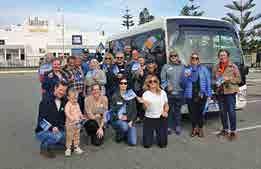
Bedford Captain George Anthony on the sands of Rockingham beach. The Catalpa rescue is rightly celebrated as a major coup for the Fenians. Following an appeal from James Wilson, one of those still immured in Fremantle Prison, the Fenian leader, James Devoy, had sought out John Boyle O’Reilly in his new home of Boston for advice as to how a rescue might be accomplished. Having escaped in a whaling ship himself, O’Reilly recommended that a whaling ship be purchased and sent on a purportedly genuine voyage to Western Australia, where the rescue would be attempted. At the Catalpa Memorial on Rockingham Beach, FFF members staged a re-enactment of the tense scene that preceded the Catalpa Six’s escape. The memorial is beautifully crafted, well-documented and definitely merits a visit. The Fenians’ escape didn’t go undetected. The alarm was given. Pursuit was rapid, and intense! In a now legendary naval encounter, Captain Anthony stared down a challenge from the steamer, Georgette, by raising the Stars and Stripes on board the Catalpa. “If you fire on this ship, you fire on the American flag!” The bluff worked, and the Fenians sailed away to freedom in the United States, where they received a rapturous welcome. Back to 1869, and the sand dunes of Australind… John Boyle O’Reilly spent most of his sentence in a bush camp outside Bunbury. Thanks to the good graces of the local Catholic priest, Father Patrick McCabe, and local Irish farmers including James Maguire of Dardanup, O’Reilly escaped the camp and took refuge in the mosquito-infested bushland of Buffalo Beach (Belvedere). The mosquitoes were certainly prolific as we met up with the Friends of John Boyle O’Reilly Association leaders, Peter Murphy, and Lachlan Kelly, who fleshed out O’Reilly’s fraught escape for us. O’Reilly’s first attempt to rendezvous with a whaling ship, the Vigilant, was foiled when the captain became skittish of the authorities and failed to meet up with O’Reilly at sea, as planned. We marvelled at O’Reilly’s resilience as he waited, alone and starving in the oppressive March heat, for McCabe and Maguire to arrange him passage on another ship, while grieving the local lass he was leaving behind—his warder’s daughter, Jessie Woodman. Eventually, O’Reilly found refuge on the Gazelle, with Captain David Gifford and second mate, Henry Hathaway, who became a lifelong mate of O’Reilly’s, helping to arrange the purchase of the Catalpa and locate the right man to captain that daring mission.
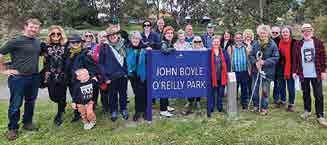
And so, on to Dardanup. Thanks to Danny Harris of the Dardanup Heritage Collective, we were able to visit the Dardanup Pioneer Cemetery, where we paid homage to James Maguire and other early settlers. Later, the group enjoyed dinner at the Dardy Tavern before attending a concert in the historic Thomas Little Hall by the Celtic Balladeers: John Wilson, Alan Ferguson, and Fred Rea. The Balladeers regaled us with a vibrant selection of Fenian-inspired songs (including the ‘Catalpa’ song, still illegal in WA). A cracking night! In Bunbury the next day, led by the dynamic O’Reilly afficionados, Peter Murphy and Lachlan Kelly, we visited the John Boyle O’Reilly Reserve which the late Liam Barry had been instrumental in establishing. Here we heard about the legend of “O’Reilly’s tree” — a magnificent giant eucalypt flagged for destruction as part of the bush detail O’Reilly was working on. With a poet’s love of beauty, O’Reilly lobbied the district commander to save the tree. Following a visit by his wife to the site, the commander diverted the road around the tree. And so, it stood, until felled in 1953. Who knew? John Boyle O’Reilly: possibly WA’s first ‘treehugger’! Then it was off to the old Post Office, where we were joined by local researcher, Barbara Kelly. Together, we reimagined the barrage of telegrams fired between Captain Anthony and Breslin in the tense runup the Catalpa rescue. Barbara used the view from the Marlston Hill scenic lookout to highlight how Maguire, Milligan and others had kept watch on the harbour from Australind to time O’Reilly’s escape. After a welcome stop at the Wellington Hotel – the former Spencer’s Hotel—and lunch at the Natural Temptation Café, we attended a public talk at the Bunbury Museum by Lachlan, Barbara, and Peter. Lachlan shared his research on the Georgette that pursued the Catalpa and Barbara Kelly spoke about her involvement in researching Peter FitzSimons runaway bestseller, The Catalpa Rescue. Peter Murphy concluded with another inspirational speech about John Boyle O’Reilly, and the mysterious role that the number “406” played in his dramatic life. With regret, but much gratitude, we farewelled our Bunbury friends and returned to Perth, singing along to Irish music, including Declan O’Rourke’s haunting ‘Convict Ways’. What a cracking weekend, rich in heritage, music, and good company, superbly organised by the Fenians, Fremantle and Freedom committee. A great way to mix a mini break with Irish heritage! ☘
